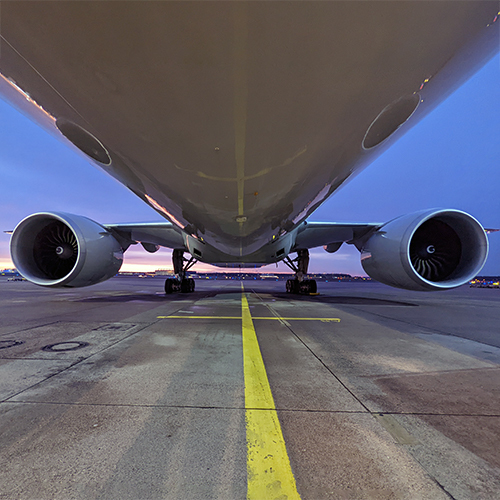Moderators: richierich, ua900, PanAm_DC10, hOMSaR
787 wing question
I was looking at the 787 today and noticed at the junction where the wing meets the body (the wing box?) that there is an intake of some sort on the right wing. What is this for? Directly below this, there is also something else--it is not flush with the wing. It is actually quite ugly and I would imagine fuel inefficient? Just wondering what it is, etc. Thanks.
Re: 787 wing question
Can you provide a picture of some sort? I think I may know what you are talking about.
-

- Florianopolis
- Posts: 382
- Joined:
Re: 787 wing question
Assuming I'm correctly guessing what you're asking about*, it's intakes for the air conditioning and pressurization system.


viewtopic.php?t=776339
*By the explicit text of your question, you could be describing the right engine.

viewtopic.php?t=776339
In the picture. below the leading edge wing root you have the ram air/heat exchanger inlet, below that is the compressor intake and just forward of the gear well are the ram air/heat exchanger exhaust doors.
*By the explicit text of your question, you could be describing the right engine.
Re: 787 wing question
Florianopolis wrote:*By the explicit text of your question, you could be describing the right engine.
lol
Re: 787 wing question
If this intake is round, then it is the ground cooling valve inlet for the nitrogen generation system. The fixed air scoop is the inlet for the Cabin Air Compressors. This replaces bleed air.
Re: 787 wing question
Florianopolis wrote:Assuming I'm correctly guessing what you're asking about*, it's intakes for the air conditioning and pressurization system.
viewtopic.php?t=776339In the picture. below the leading edge wing root you have the ram air/heat exchanger inlet, below that is the compressor intake and just forward of the gear well are the ram air/heat exchanger exhaust doors.
*By the explicit text of your question, you could be describing the right engine.
Thanks! The diagrams are great. What is the object directly below the inlet? It doesn't look like two pieces with a small gap in between? On the Qatar picture you provided, it is clearly shown.
Re: 787 wing question
I should add that if the inlet is square, then you are looking at the ram door inlet for the pack heat exchangers. This is what shows in the above picture. Other A/C have the same inlet, but on the bottom of the fuselage, and not visible at a distance.
Re: 787 wing question
If you look closely at the picture of the Qatar 787, the square flaps on the very bottom of the fuselage are the pack heat exchanger outlet doors.
-

- Florianopolis
- Posts: 382
- Joined:
Re: 787 wing question
putthoff wrote:What is the object directly below the inlet? It doesn't look like two pieces with a small gap in between? On the Qatar picture you provided, it is clearly shown.

From an old thread: viewtopic.php?t=531465&start=110
The reason the inlets stand off from the fuselage is to ensure no contaminants from the skin (e.g. de-icing fluids) can be ingested into the cabin air circuit. If a NACA duct were used, all kinds of contamination would be continuously washed into the packs whenever it flew through rain. The cleaner air feeding the cabin is one of the expected advantages of the 787 system - no potential for engine odors & contamination from a compressor bleed source.
In re the blocker door that swings out in front of the inlet:
is open when the packs are running and the airplane is on the ground and when flying at low altitudes.. They prevent objects thrown up from the runway, as well as birds from being ingested into the inlet.
you need them on the compressor inlets because the first thing you hit if you go down that duct is the spinning face of the compressor.
Re: 787 wing question
The posted diagram of the packs and air
compressors has a note stating ‘air source can be adjusted for passenger count’
Is this actually done and how does the system know the pax count, input by the crew ?
compressors has a note stating ‘air source can be adjusted for passenger count’
Is this actually done and how does the system know the pax count, input by the crew ?
Re: 787 wing question
Florianopolis wrote:putthoff wrote:What is the object directly below the inlet? It doesn't look like two pieces with a small gap in between? On the Qatar picture you provided, it is clearly shown.
From an old thread: viewtopic.php?t=531465&start=110The reason the inlets stand off from the fuselage is to ensure no contaminants from the skin (e.g. de-icing fluids) can be ingested into the cabin air circuit. If a NACA duct were used, all kinds of contamination would be continuously washed into the packs whenever it flew through rain. The cleaner air feeding the cabin is one of the expected advantages of the 787 system - no potential for engine odors & contamination from a compressor bleed source.
In re the blocker door that swings out in front of the inlet:is open when the packs are running and the airplane is on the ground and when flying at low altitudes.. They prevent objects thrown up from the runway, as well as birds from being ingested into the inlet.you need them on the compressor inlets because the first thing you hit if you go down that duct is the spinning face of the compressor.
Perfect! Thanks for the pictures and explanation. I understand how it works and the purpose. However, it seems like other planes have had such inlets without this flap? DC-* nose, the 727 on the tail, etc? How was this dealt with before compared to this design? And I guess, the real question for me is the aerodynamics of this setup. It seems like it would create significant drag? It is not inset to the body like the one above?
Re: 787 wing question
putthoff wrote:Perfect! Thanks for the pictures and explanation. I understand how it works and the purpose. However, it seems like other planes have had such inlets without this flap? DC-* nose, the 727 on the tail, etc? How was this dealt with before compared to this design? And I guess, the real question for me is the aerodynamics of this setup. It seems like it would create significant drag? It is not inset to the body like the one above?
Not sure what you mean about the B727 having it on the tail. The PACK system on the B727 is contained in the belly, with the ram air scoops straddling the centerline.
As for dealing with contaminants; that answer lies in the design of the PACK system. The aircraft that have come before, B727, B757, A300, DC10, etc. All use ram air as a cooling meduium. The air flows across the heat exchangers. Ram air is NOT used in the airframe for purposes of conditioning and pressurization, engine bleed air is. I suspect (suspect: since I have no B787 experience), with the absence of a bleed air system, ram air is used inside the cabin for pressurization and conditioning. That is why there is a contamination concern on the B787.
Re: 787 wing question
fr8mech wrote:putthoff wrote:Perfect! Thanks for the pictures and explanation. I understand how it works and the purpose. However, it seems like other planes have had such inlets without this flap? DC-* nose, the 727 on the tail, etc? How was this dealt with before compared to this design? And I guess, the real question for me is the aerodynamics of this setup. It seems like it would create significant drag? It is not inset to the body like the one above?
Not sure what you mean about the B727 having it on the tail. The PACK system on the B727 is contained in the belly, with the ram air scoops straddling the centerline.
As for dealing with contaminants; that answer lies in the design of the PACK system. The aircraft that have come before, B727, B757, A300, DC10, etc. All use ram air as a cooling meduium. The air flows across the heat exchangers. Ram air is NOT used in the airframe for purposes of conditioning and pressurization, engine bleed air is. I suspect (suspect: since I have no B787 experience), with the absence of a bleed air system, ram air is used inside the cabin for pressurization and conditioning. That is why there is a contamination concern on the B787.
Thanks so much. That is really helpful--especially filling in that the 787 doesn't use engine bleed air. I get it. I was mistaken about the 727, I thought there was an inlet located by the number 2 engine. I was thinking of the dc 9 inlet on the tail.
-

- Florianopolis
- Posts: 382
- Joined:
Re: 787 wing question
For the DC-8:
viewtopic.php?t=753219
viewtopic.php?t=725419
This is also interesting:
http://www.boeing.com/commercial/aeroma ... ticle2.pdf
They probably decided that the increase in drag was more than offset by the benefits of 1) cleaner feed air, 2) all that accrues from a "bleed-less" architecture, like increased fuel efficiency and reduced maintenance costs.
viewtopic.php?t=753219
viewtopic.php?t=725419
Each of those chin scoops have three holes. There is a large opening in the middle which takes in air for the air-to-air heat exchanger on that side. There are also two smaller holes that are the individual inlets for the turbocompressors. On the DC-8, there are a total of 4 turbocompressors.
A small amount of engine bleed air was used to spin turbo-compressors which drew in fresh air, compressed it and raised it's temperature. This air, cooled via heat exchangers and freon units, was directed to the cabin distribution system.
The Boeing 727, 737, and DC-9 generation of planes using JT8 series engines were the first to use bleed air from the engine itself, through air conditioning "packs" to directly pressurise the cabin and for temperature control.
This is also interesting:
http://www.boeing.com/commercial/aeroma ... ticle2.pdf
putthoff wrote:And I guess, the real question for me is the aerodynamics of this setup. It seems like it would create significant drag? It is not inset to the body like the one above?
They probably decided that the increase in drag was more than offset by the benefits of 1) cleaner feed air, 2) all that accrues from a "bleed-less" architecture, like increased fuel efficiency and reduced maintenance costs.
Who is online
Users browsing this forum: jetwet1 and 36 guests



